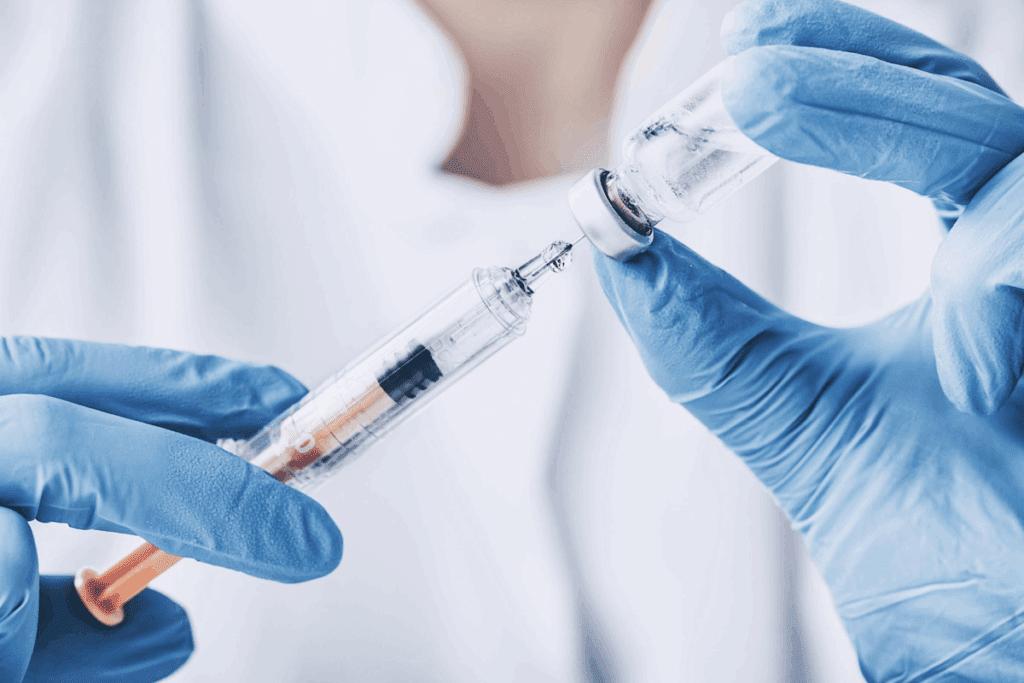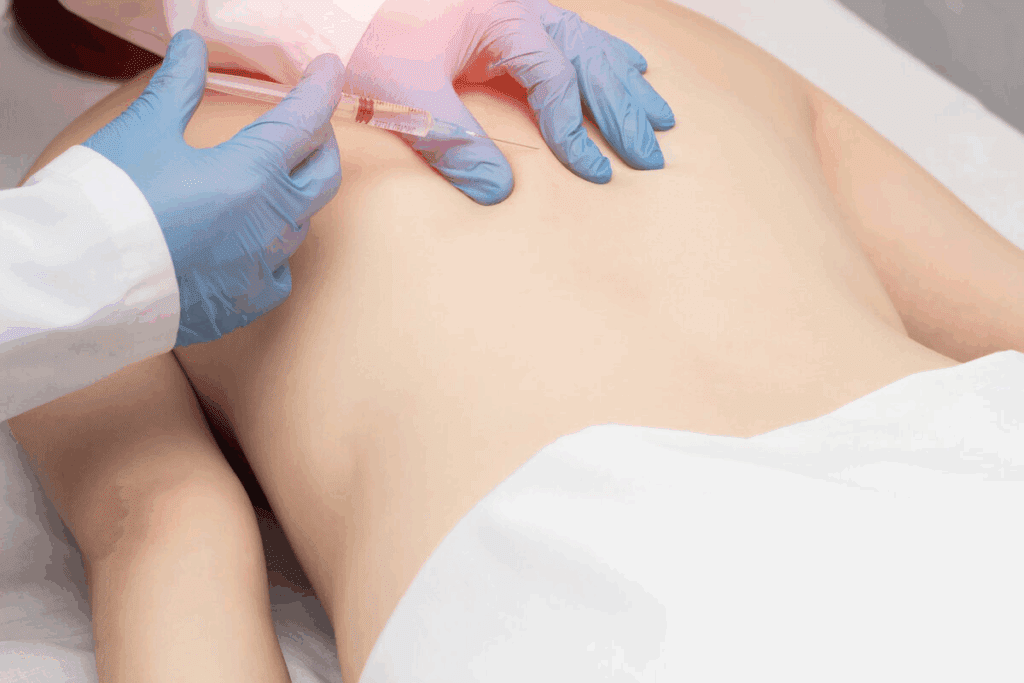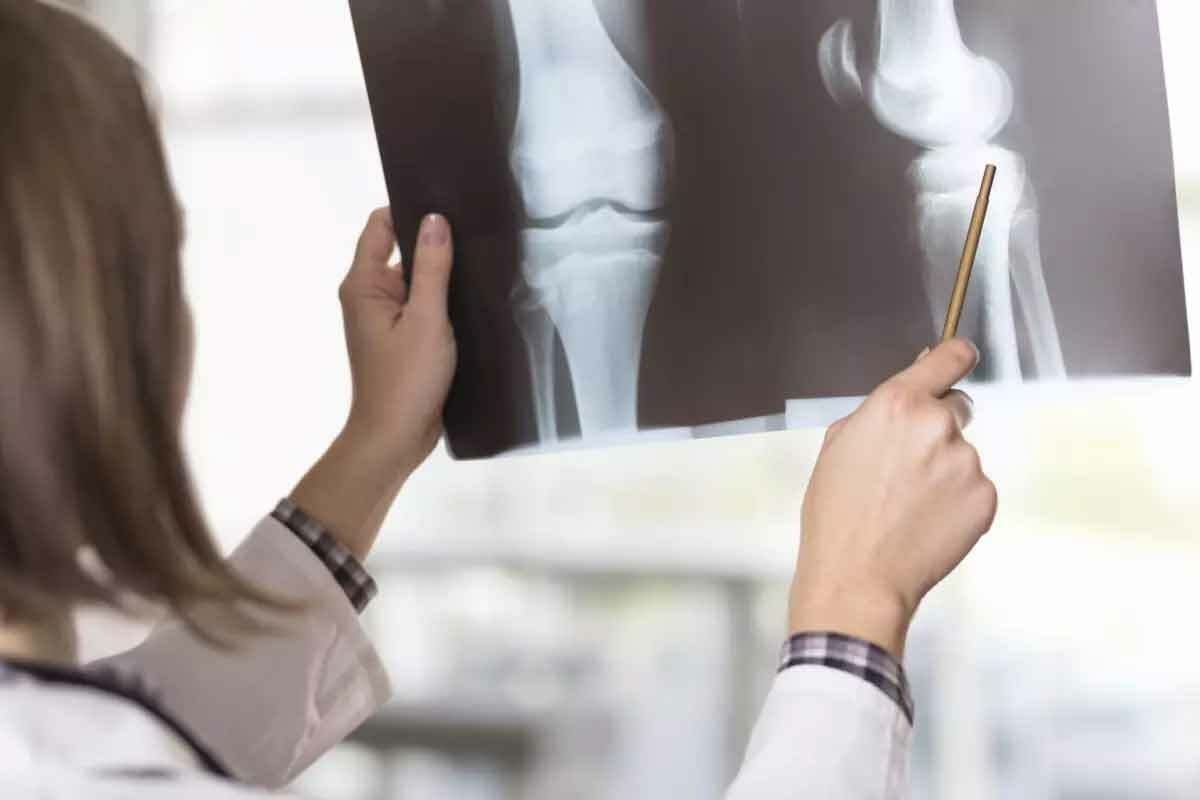Last Updated on November 26, 2025 by Bilal Hasdemir

At Liv Hospital, we know how important it is to manage pain well. Steroid shots, or corticosteroid injections, are a common way to treat pain. They help by reducing swelling and giving temporary pain relief.
We use these injections to help with pain from many medical issues. Knowing about the different types of steroid shots helps patients choose the best treatment for them.
Key Takeaways
- Corticosteroid injections are used to decrease inflammation and provide pain relief.
- Steroid shots are commonly used to treat conditions like arthritis and tendonitis.
- Understanding the different types of steroid shots is key to making good treatment choices.
- Corticosteroid injections can provide temporary pain relief.
- Effective pain management is a top priority at Liv Hospital.
Understanding Steroid Shot for Pain: Definition and Basics

Corticosteroid injections are a targeted way to manage pain. They are different from treatments that affect the whole body. These shots are made to cut down inflammation and ease pain in specific spots, like joints and irritated nerves.
What Are Corticosteroid Injections
Corticosteroid injections are anti-inflammatory meds put right into the painful spot. They’re a common choice for many muscle and bone problems.
“Corticosteroid injections can provide significant relief for patients with chronic pain who have not responded to other treatments.”
These shots work by lowering inflammation, which often causes pain. By focusing on the pain source, they can offer relief with fewer side effects than other steroids.
How They Differ from Other Pain Treatments
Unlike oral steroids or IV treatments, corticosteroid injections go straight to the problem area. This targeted method can lower the chance of side effects seen with other steroids.
Doctors say, “The localized effect of corticosteroid injections makes them an attractive option for patients seeking to avoid the systemic effects of steroids.” This is great for those needing ongoing pain relief.
The Science Behind How Steroid Shots Work

Steroid shots help manage pain by reducing inflammation. They are injected into the affected area. This process helps lessen pain and swelling.
Anti-inflammatory Mechanism
Steroid shots mimic cortisol, a hormone that fights inflammation. When injected, they cut down inflammation. This leads to less pain and swelling.
Duration of Effectiveness
The time steroid shots last varies. They can work from weeks to months. The exact time depends on the corticosteroid type, the condition, and how well the body responds.
| Corticosteroid | Typical Duration of Effectiveness |
| Triamcinolone | Several weeks to a few months |
| Methylprednisolone | A few weeks to several months |
| Betamethasone | Several weeks |
Knowing how steroid shots work and how long they last helps both patients and doctors. It aids in making better choices for pain management.
Types of Steroids Used in Medical Treatment
Steroids in medicine are often misunderstood. They are used to treat many conditions, from inflammation to cancer. We’ll look at the different types of steroids used in medical treatments.
Corticosteroids vs. Anabolic Steroids
“Steroid” is often mixed up with “anabolic steroid,” which boosts muscle. But in medicine, steroids usually mean corticosteroids. They are powerful against inflammation and help the immune system. Corticosteroids are not the same as anabolic steroids; they treat many medical conditions, like asthma and arthritis.
Anabolic steroids are synthetic testosterone, used to grow muscles and improve sports performance. They are closely watched because of side effects and misuse. Corticosteroids, on the other hand, are for medical conditions and don’t build muscles.
“Corticosteroids are a cornerstone in the treatment of inflammatory diseases, providing relief for patients with conditions such as rheumatoid arthritis and severe allergies.”
Common Corticosteroids for Medical Use
Many corticosteroids are used in medicine. Prednisone is often prescribed for its anti-inflammatory and immunosuppressant effects. It helps with asthma, rheumatoid arthritis, and skin issues.
Methylprednisolone is another common corticosteroid, available orally and by injection. It’s used for similar reasons as prednisone but has a different side effect profile.
- Prednisolone: Used in the treatment of inflammatory conditions.
- Dexamethasone: A potent corticosteroid used for severe inflammation and certain types of cancer.
- Triamcinolone: Often used for skin conditions and injected into joints for localized inflammation.
These corticosteroids are key in managing many medical conditions. They offer significant relief to those with inflammatory diseases. Knowing the differences and uses of these medications is important for effective treatment.
Common Medical Conditions Treated with Steroid Shots
Steroid injections are used to treat many health issues. This includes joint pain and other inflammatory conditions. They are a flexible treatment that can help with different medical problems.
Joint and Muscle Conditions
Steroid shots are often used for joint and muscle issues like arthritis, bursitis, and tendonitis. These problems cause inflammation, leading to pain and discomfort. Steroid shots reduce inflammation, easing symptoms and improving life quality.
Other Medical Uses for Steroids
Steroid shots are also used for other health issues. They can help with inflammation in the spine or treat plantar fasciitis. They are also used to manage pain and inflammation from certain cancers.
In summary, steroid shots are a valuable treatment for many medical conditions. They are great for joint and muscle pain. Their ability to reduce inflammation makes them effective in managing symptoms and improving patient outcomes.
The Procedure: What to Expect When Getting a Steroid Shot for Pain
The steroid shot procedure might seem scary, but it’s a common treatment. We’ll walk you through what happens to make it easier.
Preparation Before the Injection
Preparation is important before getting a steroid shot. You’ll likely have a medical history check and a quick physical exam. Tell your doctor about any medicines you’re taking or allergies you have.
On the day, wear comfy clothes that are easy to move in. You might be told not to eat a big meal before.
During the Procedure
The area gets cleaned with an antiseptic before the shot. You might get a local anesthetic to numb the area. Then, the steroid is injected with a sterile needle.
The whole thing usually takes a few minutes. But it can take longer based on your case and where the shot is given.
Immediate Aftercare
Right after, you’ll be watched for any bad reactions. You might feel some soreness or swelling, but it should go away in a few hours.
Post-procedure care instructions will be given. You might need to rest and use ice to reduce swelling. Having someone with you when you go home is a good idea.
Knowing what to expect from the steroid shot procedure helps you prepare. It makes the treatment and recovery easier.
Alternative Forms of Steroid Administration
Steroids can be given in many ways, not just by injection. This makes it easier for doctors to find the best treatment for each patient.
Oral Steroids: Tablets and Capsules
Oral steroids come in tablets and capsules. They are good for serious conditions like severe asthma or some autoimmune diseases. Oral steroids are absorbed into the blood, helping to fight inflammation and suppress the immune system all over the body.
But oral steroids can cause side effects, like weight gain and mood changes. They can also increase the chance of getting infections. So, they are only used for short periods or when other treatments don’t work.
Topical Steroids
Topical steroids are applied to the skin or mucous membranes. They are often used for skin problems like eczema, dermatitis, and psoriasis. Topical steroids help reduce inflammation and itching, helping those with skin issues.
The strength of topical steroids varies a lot. Some are mild and available over-the-counter, while others are stronger and need a prescription. The right choice depends on how bad the skin problem is and where it is.
Other Delivery Methods
There are other ways to give steroids, too. Inhalers are used for breathing problems like asthma, sending steroids straight to the lungs. Rectal forms are used for some stomach issues, giving relief locally.
These different ways of giving steroids can help target the treatment better. This might lower the risk of side effects all over the body. The method chosen depends on the condition, its severity, and the patient’s health.
Benefits and Limitations of Steroid Injections
Steroid injections are used to manage pain and have both good and bad sides. They are a common treatment for many conditions. They work by reducing inflammation and pain.
Primary Benefits
Steroid injections have several advantages:
- Effective Pain Relief: They can greatly reduce pain and inflammation. This improves the quality of many patients.
- Reduced Inflammation: By lowering inflammation, they help the affected area function normally again.
- Minimally Invasive: The procedure is simple and quick. Most patients can go back to their usual activities soon after.
Limitations and Contraindications
Despite their benefits, steroid injections have limitations and certain conditions where they should not be used. Some of these include:
- Temporary Relief: The pain relief from steroid injections is usually short-lived. Patients may need repeated injections for lasting relief.
- Potential Side Effects: Steroid injections can cause side effects. These can range from mild to severe, including infection, nerve damage, and systemic effects.
- Contraindications: Certain conditions, like diabetes, hypertension, and infections, may make steroid injections risky. They may need careful consideration or be avoided altogether.
It’s important to consider both the benefits and limitations of steroid injections. We must think about each patient’s unique situation when deciding if they are a good treatment option.
Potential Side Effects and Risks of Steroid Treatment
Steroid shots can help with inflammation and pain, but come with side effects. It’s important for patients to know these risks. This helps them make better choices about their treatment.
Common Side Effects
Most people get some side effects from steroid shots. These are usually mild and short-lived. Common side effects include:
- Pain at the injection site
- Flushing or redness of the face
- Temporary high blood sugar levels
- Sleep disturbances
- Mood changes
These side effects usually go away in a few days. But if they don’t or get worse, see your doctor.
Rare but Serious Complications
Even though rare, serious problems can happen with steroid shots. These include:
- Infections at the injection site
- Tendon damage or rupture
- Allergic reactions to the steroid or other components of the injection
- Nerve damage
If you have severe pain, swelling, or trouble moving, get medical help right away.
Risk Factors to Consider
Some things can make side effects or complications more likely. These include:
| Risk Factor | Description |
| Diabetes | Steroid shots can raise blood sugar levels, which is a problem for diabetics. |
| Previous allergic reactions | Those who have had allergic reactions to steroids or other parts of the shot are at higher risk. |
| Weakened bones (Osteoporosis) | Using steroid shots often can make bones thinner, raising the chance of fractures. |
Knowing these risk factors helps both patients and doctors make better choices about using steroids.
Being aware of side effects and risks helps patients choose their treatment wisely. They can work closely with their doctors to avoid problems.
Symptoms of Coming Off Steroids and Management Strategies
Stopping steroids needs careful planning to avoid withdrawal symptoms. Steroids help with many health issues, but can make it hard to stop. We’ll help you understand common symptoms, tapering plans, and when to see a doctor.
Common Withdrawal Symptoms
Stopping steroid treatment can lead to withdrawal symptoms. These include:
- Fatigue
- Joint pain
- Dizziness
- Mood changes
It’s important to know these symptoms to manage them well. Doctors say, “Understanding withdrawal is key to lessening its impact.” The severity of symptoms depends on how long and how much you took steroids.
Tapering Protocols
Tapering protocols slowly lower steroid doses to reduce symptoms. This plan is tailored to each patient, based on their health, the steroid type, and treatment length.
A doctor will make a tapering schedule. This might involve lowering doses over weeks or months.
“Tapering is not just about reducing the dose; it’s about giving the body time to adjust to the change.”
When to Seek Medical Attention
While tapering off steroids, watch your health closely. See a doctor if you notice:
- Severe mood changes or depression
- Increased pain or inflammation
- Signs of adrenal insufficiency, such as extreme fatigue or dizziness
Quick medical help can prevent serious problems. Your doctor can adjust your tapering plan or offer extra treatment if needed.
Conclusion: Making Informed Decisions About Steroid Treatment
Steroid shots are a valuable treatment for managing pain and inflammation. Knowing how steroids work and their uses is key. This knowledge helps in making smart choices about treatment.
We’ve looked at how steroid shots work and their benefits and risks. This information helps people decide on their treatment. It’s important to talk to a healthcare professional to find the right treatment.
Knowing the risks and benefits of steroid treatment is vital. This way, people can make choices that fit their health goals. Steroids can effectively manage pain and improve life quality when used correctly.
In conclusion, understanding treatment options is essential. We hope this article has given you the insights you need. It’s about empowering you to take charge of your health and make informed decisions.
FAQ
What are corticosteroid injections used for?
Corticosteroid injections help manage pain from different medical conditions. They are often used for joint and muscle issues by reducing inflammation.
How do steroid shots work?
Steroid shots inject corticosteroids into the affected area. This reduces inflammation and eases pain.
What is the difference between corticosteroids and anabolic steroids?
Corticosteroids treat inflammation and are used in medicine. Anabolic steroids help grow muscles and are linked to sports performance.
What are the common corticosteroids used for medical purposes?
Triamcinolone, methylprednisolone, and betamethasone are common corticosteroids. They treat various inflammatory conditions.
What conditions are treated with steroid shots?
Steroid shots treat joint and muscle issues like arthritis and tendinitis. They also help with other inflammatory conditions.
How long do steroid shots last?
The effect of steroid shots varies by condition and individual response. They usually provide relief for weeks to months.
What are the alternative forms of steroid administration?
Steroids can be taken orally, topically, or through inhalers. These methods are used for different conditions.
What are the benefits of steroid injections?
Steroid injections quickly reduce inflammation and pain. This improves mobility and function.
What are the side effects of steroid treatment?
Side effects include skin thinning and weight gain. Rare but serious issues like osteoporosis and infections can also occur.
How do I manage withdrawal symptoms when stopping steroid treatment?
Follow a tapering protocol under medical supervision. This gradually reduces dosage and minimizes side effects.
What are the symptoms of coming off steroids?
Symptoms include fatigue, muscle and joint pain, and mood changes. They vary based on treatment duration and dosage.
When should I seek medical attention after stopping steroid treatment?
Seek medical help for severe or persistent withdrawal symptoms. Also, if you have concerns about your treatment or health.
Reference:
Cole, J. L. (2020). Steroid-induced sleep disturbance and delirium: A focused review for critically ill patients. PMC, 7357890. Retrieved from https://www.ncbi.nlm.nih.gov/pmc/articles/PMC7357890/






